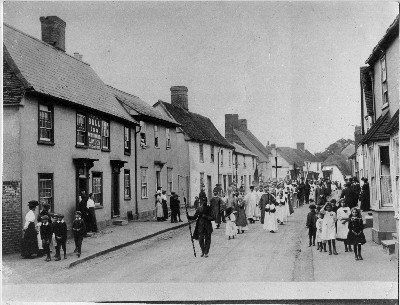A Brief History of a Wonderful Building
The parish of Thaxted is in the Deanery of Saffron Walden, the Archdeaconry of Stansted, the Diocese of Chelmsford, and the Province of Canterbury.
Thaxted Church is one of the grandest in the county of Essex, 183 feet long and 87 feet wide, and so beautiful that it may well claim to be the Cathedral of Essex. The Church stands on a hill and dominates the town. From whichever direction the visitor approaches, the splendid spire can be seen many miles away. It has been described as the finest parish church in the country, and has both beauty and grandeur. There is an excellent 'walk around' guide in the church available to visitors.
The building began in 1340, and its growth continued through our great building centuries till the Reformation, and the result is a proud example of English architecture. It was completed in 1510. Perfect balance is achieved with the aisles and transepts, chapels and the two porches, the King's and the Duke's, for Edward the Fourth gave the one with his arms on it (North porch), and Lionel, Duke of Clarence gave the other marked with his coronet (South porch). Both porches are vaulted, and both have a spiral stair leading to a room above and ending in a turret. The Church was built in the form of a cathedral, with a fine crossing between the main body and the chancel. The hexagonal pulpit, with canopy and ogee-shaped base, dates from c.1680. The roof is early 16th century and comprises six bays.
The chancel is flanked by two side chapels. The left or North side is dedicated to St Thomas of Canterbury, and is generally called 'the Becket chapel'. The right or South side is dedicated to Jesus' mother, Mary, and his maternal grandmother, Ann. Formally known as the chapel of 'Our Lady and Our Lady Anne, it is generally called 'the Lady chapel'.
The chapel in the south transept is dedicated to St Catherine of Alexandria, who was condemned to death in 800AD nailed to a cart wheel. This area is now used as the Vestry but the statue to St Catherine can still be seen above the screen.
The chapel in the north transept is dedicated to St Laurence, deacon of Rome, but has also been known as Trinity Aisle, and the Singers' Chapel. Since 1858 the chapel has been the home of the Lincoln Organ.
The Stellar, the great star-shaped candelabra which hangs in the cross-aisle, was designed by the architect, Randall Wells. It was originally designed for St Mary's Church, Primrose Hill, London NW3, but was never erected there. It has been in Thaxted Church since 1910 and tells the Christmas story, Matthew 1. 1-17. There are 42 lights made up of 3 x 14. There were 14 generations from Abraham to King David, 14 generations from King David to the Flight into Egypt, and 14 generations from the Flight into Egypt to the birth of Jesus Christ in Bethlehem. The ball below the 42 lights symbolises the world; therefore, Jesus, the Light of the World.
There are three organs: the largest was built by Henry Lincoln in 1820 and came here from St John's Chapel, Bedford Row, London, in 1858. The smallest 'Conrad Noel Memorial Organ' beneath the tower arch was built in 1952 by Cedric Arnold with money raised on the death of the late Fr Conrad Noel, vicar of Thaxted 1910-42. The Thaxted Music Festival has a Makin electronic organ which is located in front of the Tower and is used by the church for most of its music.
The organ built by Henry Lincoln around 1820 was rarely played due to its failing condition and its need of restoration. It was originally built for St. John's Chapel, Bedford Row, London but moved to Thaxted in 1858, and was in active use here until the 1960s. Over the 150 years in Thaxted, the instrument was not repaired or altered. The Organ was finally restored fully in 2013/2014 and returned to its place in the church during 2014. It will become an important musical resource for scholars around the country.
The pews were removed in 1879 and supplanted by chairs during the incumbency of the late Fr George Symonds. To mark the Jubilee of Queen Elizabeth II a new set of chairs was placed in the church, some dedicated to families who subscribed to their purchase.
It is possible that Fr George Symonds re-established the Reservation of the Blessed Sacrament in the Church. It was not until Easter 1911 that the regular burning of incense on Sundays and other festivals was recommenced.
Eight bells hang in the 15th Century West Tower: the treble bell weighs 3.75 cwt, and the tenor weighs 15 cwt. They are housed in the upper part of the tower which is 80 feet high. If the wind is in a certain direction, the bells have been heard as far as Great Dunmow - 7 miles away! The stone spire, said to be the only mediaeval stone spire in Essex, originally rose to a height of 183 feet, but now rises to a height of 181 feet (the loss of two feet occurred due to an error when it was rebuilt in 1822) and can be seen for many miles around. It is similar to many built in Northamptonshire. It has twice been destroyed by lightning and each time has been built up again to the original design.
There is much ancient stained glass in the church. The oldest is a picture of a knight in the South Transept and dated about 1341. It is reputed to be Edmund, Earl of March, who owned a part of the Manor at that time. The chancel and Becket chapel east windows date from 1900 and are by C.E.Kempe, a noted Victorian glazier.
In 2014 the old furnace that provided heat for the church gave up the ghost and in the following year a new system was installed consisting of hot water fed radiators. This brought warmth to all parts of the church, even the chapels. Installed by C.Dunphy Ltd it is fully controlled by heat sensors and a flexible timing mechanism.
During 2014 and 2015 the church family held many discussion about its future. Following the retirement of Fr Raymond Taylor the Bishop had stated that Thaxted could no longer continue as a single parish and should move to join with others and share a priest. The long held decision of the parish that it would hold to Resolutions A and B (no women priests) was a barrier to such change. After long and painful debate and prayer the whole family met and voted by 80% that we should recind Resolutions A and B.
Following this, agreement was reached to join with the Benefice of the Sampfords, Radwinter and Hempstead. The priest in charge of that benefice (Fr Philip Tarris) was also appointed Priest in Charge of Thaxted. The creation of the new joint benefice took place on June 13th 2017 with a service in Thaxted Church led by Bishop Roger.
Thanks to Thaxted Parish Council for parts of this short history.




